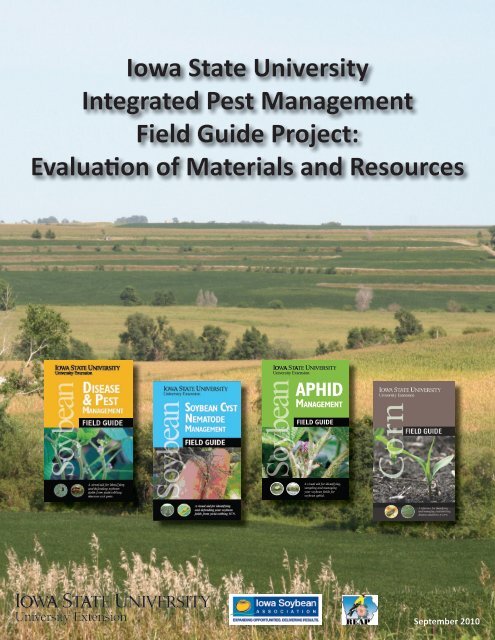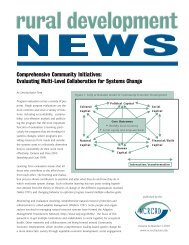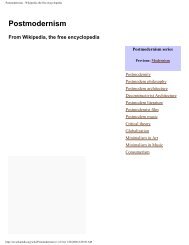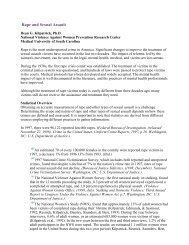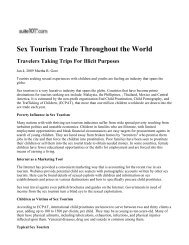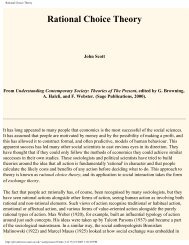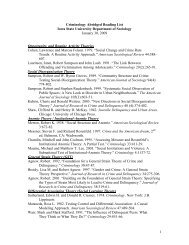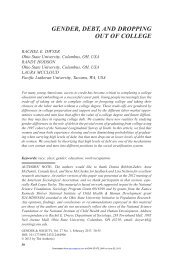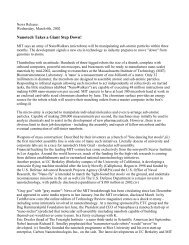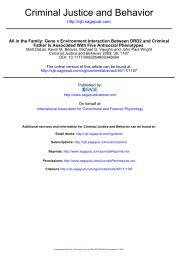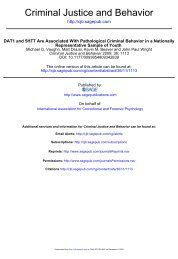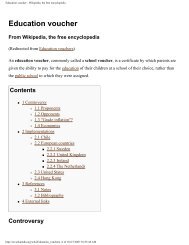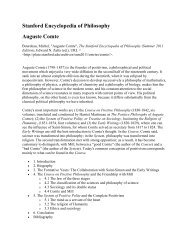Iowa State University Integrated Pest Management Field Guide ...
Iowa State University Integrated Pest Management Field Guide ...
Iowa State University Integrated Pest Management Field Guide ...
Create successful ePaper yourself
Turn your PDF publications into a flip-book with our unique Google optimized e-Paper software.
<strong>Iowa</strong> <strong>State</strong> <strong>University</strong><br />
<strong>Integrated</strong> <strong>Pest</strong> <strong>Management</strong><br />
<strong>Field</strong> <strong>Guide</strong> Project:<br />
Evaluation of Materials and Resources<br />
Soybean<br />
APHID<br />
MAnAgeMent<br />
<strong>Field</strong> <strong>Guide</strong><br />
A visual aid for identifying,<br />
sampling and managing<br />
your soybean fields for<br />
soybean aphid.<br />
September 2010
INTRODUCTION<br />
A central goal of integrated pest management (IPM) is to reduce the unnecessary use of pesticides. For<br />
<strong>Iowa</strong> growers, IPM can improve the economic and environmental performance of corn and soybean production.<br />
A successful IPM system begins with correctly identifying pests and disease, then understanding<br />
the biophysical relationships between them and the crops they attack. The <strong>Iowa</strong> <strong>State</strong> <strong>University</strong> (ISU)<br />
Corn and Soybean Initiative staff in collaboration with ISU faculty and staff in the College of Agriculture<br />
and Life Sciences and ISU Extension has developed four field guides—one specific to corn and three to<br />
soybean—to aid pest and disease identification in the field.<br />
The ISU soybean and corn field guides were developed for widespread distribution in <strong>Iowa</strong> and neighboring<br />
states. These guides are meant to be convenient, basic references for teaching the principles of<br />
IPM for the two most widely grown crops in <strong>Iowa</strong>.<br />
The Corn and Soybean Initiative has disseminated over 250,000 guides to growers, crop advisers, agribusiness<br />
professionals, and agricultural educators as a resource to support IPM-based management<br />
decisions. For growers and crop advisers, the guides are meant to improve the ability to scout pests and<br />
make decisions in the field. For educators, the Corn and Soybean Initiative staff developed PowerPoint<br />
modules that illustrate general IPM principles and facilitate the teaching of IPM in the classroom.<br />
In fall 2009, the Corn and Soybean Initiative received a grant from the <strong>Iowa</strong> Resource Enhancement and<br />
Protection (REAP) Conservation Education Program (CEP) to 1) develop IPM learning modules for use<br />
in agricultural education classrooms, 2) distribute the field guides and modules to agricultural educators<br />
across <strong>Iowa</strong>, and 3) evaluate the effectiveness and utility of those resources and collect feedback<br />
on ways that they might be improved. Two web-based surveys were conducted, one of crop advisers<br />
and agribusiness professionals and one of agricultural educators. Both surveys were conducted in spring<br />
2010. This report presents the results of those surveys.<br />
The report consists of three sections. This introductory section provides background information on the<br />
field guide project, including the rationale for the development of the field guides and modules and the<br />
objectives of the evaluation project. The second section consists of two stand-alone summaries of the<br />
evaluation findings. These two-page documents were developed to be concise summaries of survey findings<br />
appropriate for wide dissemination. The final section contains the full tabulation of the quantitative<br />
data collected through the surveys.<br />
NEED FOR IPM<br />
Since the end of World War II, chemically-intensive farming techniques have been adopted by most U.S.<br />
farmers. Farmers now apply over 1.2 billion pounds of pesticides annually. In <strong>Iowa</strong>, corn and soybean are<br />
grown on approximately 23 million acres each year. Although these acreages have remained consistent<br />
for several decades, there have been significant changes in production practices the past 10 years that<br />
have in turn affected statewide pesticide use. In addition, the average age of <strong>Iowa</strong> farmers was 56 in<br />
2007, so the bulk of row crop acres farmed in <strong>Iowa</strong> soon will be passed from this generation of farmers<br />
to the next generation. This upcoming generational shift will be challenging, but it also presents a clear<br />
opportunity for reinvigorating the concept of integrated pest management among the people making<br />
day-to-day decisions on the land. Education about IPM for both the current and the next generation of<br />
farmers is critical to ensure that pesticides are used in economically and environmentally sound ways,<br />
and especially only when appropriate.<br />
1
PROJECT OBJECTIVES AND ACTIVITIES<br />
The primary goal of the <strong>Field</strong> <strong>Guide</strong> education project is to raise awareness of IPM for growers of corn<br />
and soybean—the two crops that are annually planted on two-thirds of the land surface of <strong>Iowa</strong>—by<br />
providing IPM resources to crop advisers, agribusiness professionals, and educators.<br />
It is important to educate both the current and next generation of growers; those who provide agronomic<br />
support services to growers; and others who may influence growers to increase the adoption of IPM<br />
when using pesticides. This transfer of knowledge can promote sustainable <strong>Iowa</strong> corn and soybean production<br />
by emphasizing that IPM-based disease, insect and weed management is both cost-effective and<br />
protective of the environment. The long-term aim of this project is to provide resources that facilitate<br />
improved IPM decision-making by raising both the awareness of the side effects of increased pesticide<br />
use and aiding the ability to make limited and appropriate use of pesticides in future growing seasons.<br />
Objective 1. Development of six PowerPoint learning modules that will help with education about<br />
environmentally appropriate and economically effective pest management systems.<br />
Six PowerPoint modules that contain specific learning exercises designed to cover different aspects of<br />
IPM were developed and distributed along with the guides. The modules were produced by the Corn<br />
and Soybean Initiative staff in consultation with appropriate state extension specialists. Each of the modules<br />
includes notes for instructors. The topics were:<br />
1. Introduction to IPM: The first module provides an overview of IPM.<br />
2. Scouting basics: This module provides the basics of when, where and how to scout corn<br />
and soybeans for pest populations and the damage they cause.<br />
3. Disease management: Diseases are managed through genetic resistance, planting diseasefree<br />
seed, tillage, crop rotation, adjusting planting or harvest dates, fungicide seed treatments<br />
and foliar fungicides. This module covers how each management option fits within<br />
an IPM program for economic and environmental effectiveness.<br />
4. Insect management: Insects are managed with genetic resistance, crop rotation, tillage,<br />
adjusting planting date, weed control, insecticide seed treatments and foliar insecticides.<br />
This module covers how each management option fits within an IPM program for economic<br />
and environmental effectiveness.<br />
5. Weed management: This module covers how to manage weeds within an IPM program for<br />
economic and environmental effectiveness.<br />
6. Consequences of overuse of pesticides: This module explains consequences of indiscriminate<br />
pesticide use and how to avoid them.<br />
Objective 2. Dissemination of IPM educational materials and corn and soybean field guides to agricultural<br />
educators.<br />
Five hundred packages of all three resources (two field guides and CD with the six PowerPoint modules)<br />
were distributed to educators across <strong>Iowa</strong>. The recipients were:<br />
• 240 high school teachers<br />
• 120 post-secondary teachers<br />
2
• 125 conservation specialists (conservation offices and county weed commissioners/<br />
boards of supervisors)<br />
• 15 other contacts (<strong>Iowa</strong> Department of Agriculture and Land Stewardship <strong>Pest</strong>icide Bureau<br />
and <strong>Iowa</strong> Department of Natural Resources)<br />
Objective 3. Implementation of surveys of agricultural educators and crop advisers to a) measure the<br />
acceptance, ease of use, and suitability of the materials, and b) identify further IPMrelated<br />
information needs.<br />
Two web-based surveys were conducted. One survey targeted the agricultural educators who received<br />
the field guides and related resources. The second survey targeted the crop advisers and agribusiness<br />
professionals who had received the field guides.<br />
The survey of the educators was sent at the end of spring term 2010 to elicit feedback on the field<br />
guides and associated resources. The survey was designed based on the assumption that 1) some teachers<br />
would have employed the materials in the classroom, 2) others would have reviewed the materials<br />
but not used them yet but intended to use them in the future, and 3) others would have reviewed<br />
the materials but decided not to use them. The survey was designed to collect data that would enable<br />
project personnel to a) assess the effectiveness of the field guides, curricula and modules as educational<br />
tools, and b) identify potential ways that they might be improved. We asked educators a series of questions<br />
about initial perceptions regarding appropriateness and suitability for classroom use, intentions to<br />
incorporate them into their educational programming, and ideas for further development of IPM-related<br />
educational curricula. The survey also sought to identify additional IPM-related educational needs<br />
among these key audiences who can influence pesticide use among current and future farmers.<br />
The other survey focused on the primary end-users of the field guides: the crop advisers and agribusiness<br />
professionals who serve growers and help them make decisions about pesticide use. The corn and<br />
soybean field guides that are the foundation of this project have been and continue to be disseminated<br />
widely to farmers and the agricultural advisers with whom they work. Thousands of farmers, crop advisers,<br />
and agribusiness professionals have received copies of one or more of the field guides. Initial anecdotal<br />
feedback from these users indicated enthusiastic appreciation and support for these resources.<br />
The survey was designed to collect quantitative and qualitative data to systematically assess the adequacy<br />
of the field guides among this critical group. Similar to the survey of educators, it collected evaluative<br />
data on the guides, gathered input on their practical effectiveness, and elicited input on potential improvements<br />
and future information needs of crop advisers and agribusiness professionals.<br />
LIMITATIONS OF THE EVALUATION<br />
The evaluation research that forms the foundation of this report represents a systematic, rigorous effort<br />
to collect data on the effectiveness of the field guides and educational materials developed by the Corn<br />
and Soybean Initiative. Nevertheless, it is important to note limitations of this research.<br />
The primary limitation is related to sampling. Neither the educator nor crop adviser samples can be<br />
considered random samples of the respective populations. The crop advisers and agribusiness personnel<br />
sample population consisted of all who had received at least one field guide prior to the survey. Due to<br />
the massive and diffused distribution of field guides, it was not possible to develop a list of all recipients<br />
from which to draw a random sample. As an alternative, a convenience sample was constructed from<br />
a list of known field guide recipients. Similarly, the sample of agricultural educators was compiled from<br />
email lists that Corn and Soybean Initiative personnel had compiled over time. Thus, any generalization<br />
of results to greater populations must be done with caution.<br />
3
Despite these limitations, the data collected through the surveys represent comprehensive assessments of the<br />
materials by people who have used them in the field and the classroom. While the samples are not necessarily<br />
representative, the individuals who chose to participate are key stakeholders who were selected for the study<br />
because their feedback is seen as valuable. They have employed the resources in real-world situations and their<br />
opinions are critically important to understanding the strengths and weaknesses of the materials.<br />
THE REST OF THE REPORT<br />
This project is conceived of as a long-term effort to improve the economic and environmental efficiency of corn<br />
and soybean production in <strong>Iowa</strong> and across the Corn Belt. The evaluation research presented in the following<br />
sections represents an initial assessment of the project and resources that the Corn and Soybean Initiative views<br />
as critical to helping <strong>Iowa</strong> farmers reach that goal. An understanding of 1) the effectiveness of the field guides<br />
and related educational materials, and 2) potential ways that these materials might be improved or new materials<br />
developed will help the Corn and Soybean Initiative to better serve key stakeholders and support the longterm<br />
sustainability of <strong>Iowa</strong> agriculture. The authors wish to thank the many agricultural educators, crop advisers,<br />
and agribusiness professionals who took the time to complete the surveys.<br />
4
Use of IPM <strong>Field</strong> <strong>Guide</strong>s and Educational<br />
Materials Survey: Agricultural Educators<br />
INTRODUCTION<br />
With rising input costs and the recent resurgence<br />
and introduction of new diseases and<br />
insect pests, the need for <strong>Integrated</strong> <strong>Pest</strong><br />
<strong>Management</strong> (IPM) to maintain productivity<br />
and profitability has increased. The objective<br />
of this project is to contribute to the longterm<br />
economic and environmental performance<br />
of corn and soybean production.<br />
An important step toward the realization of<br />
this goal is education of the next generation<br />
of growers.<br />
In 2008 and 2009, the <strong>Iowa</strong> <strong>State</strong> <strong>University</strong><br />
(ISU) Corn and Soybean Initiative staff collaborated<br />
with the <strong>Iowa</strong> Soybean Association<br />
and <strong>Iowa</strong> <strong>State</strong> <strong>University</strong> faculty and staff in<br />
the College of Agriculture and Life Sciences<br />
and ISU Extension to create a series of field<br />
guides.<br />
• Soybean Disease and <strong>Pest</strong> <strong>Management</strong><br />
<strong>Field</strong> <strong>Guide</strong><br />
• Soybean Aphid <strong>Management</strong> <strong>Field</strong><br />
<strong>Guide</strong><br />
• Soybean Cyst Nematode (SCN)<br />
<strong>Management</strong> <strong>Field</strong> <strong>Guide</strong><br />
• Corn <strong>Field</strong> <strong>Guide</strong><br />
Development and distribution of the field<br />
guides was funded by the <strong>Iowa</strong> Soybean Association,<br />
the <strong>Iowa</strong> Certified Crop Advisers<br />
(CCA) board, industry sources, the ISU Corn<br />
and Soybean Initiative and ISU Extension. To<br />
date, more than 250,000 copies of the field<br />
guides have been produced, with reprints for<br />
several of the titles currently pending.<br />
In 2009, ISU Extension developed a series of<br />
IPM educational modules that, together with<br />
the Soybean Disease and <strong>Pest</strong> <strong>Management</strong><br />
and Corn <strong>Field</strong> <strong>Guide</strong>s, serve as curricula for<br />
IPM educational activities.<br />
In May 2010, agricultural educators were surveyed<br />
to assess their experiences with the<br />
educational modules and field guides and to<br />
obtain opinions about strengths and potential<br />
areas for improvement. This publication<br />
contains a summary of the survey results.<br />
HIGHLIGHTS OF THE SURVEY<br />
Agricultural educators were asked a series of questions about the effectiveness of the<br />
materials and potential avenues for improvement. Of the 51 educators who completed<br />
the survey, 49 percent had used the materials in their classrooms and 43 percent had<br />
reviewed the materials and planned to use them in the future. This summary reports the<br />
results for the teachers who had used the IPM materials in the classroom.<br />
Teachers who had employed the field guides and modules in their classrooms had used<br />
them in an average of 6.4 class periods, and taught an average of 21 students in each<br />
classroom.<br />
How effective were the guides as teaching tools?<br />
One hundred percent of respondents who had used the materials in their classrooms<br />
rated the field guides as effective or very effective.<br />
Effecve<br />
Soybean Disease &<br />
<strong>Pest</strong> <strong>Management</strong> <strong>Guide</strong><br />
Very effecve<br />
38%<br />
62% 65%<br />
35%<br />
Corn <strong>Field</strong> <strong>Guide</strong><br />
How effective were the modules?<br />
Respondents were asked to assess the effectiveness of each of the educational<br />
modules. All six modules were rated as effective or very effective by at least<br />
three-quarters of respondent.<br />
Introducon to IPM<br />
Scoung<br />
Disease management<br />
Insect management<br />
Weed management<br />
Consequences<br />
0 10 20 30 40 50 60 70 80 90 100<br />
Percent<br />
Somewhat effecve<br />
Effecve or very effecve<br />
Did not use<br />
September 2010
Do the guides lead to increases in knowledge of IPM?<br />
Educators were asked to rate IPM knowledge—<br />
both their own and their students’—before<br />
and after using the field guides and modules.<br />
Educators indicated that use of the materials<br />
resulted in a substantial increase in both their<br />
own and their students’ knowledge of IPM.<br />
Students' level of knowledge<br />
of IPM before using the field<br />
guides and related materials<br />
Students' level of<br />
knowledge of IPM now<br />
Your level of knowledge of IPM<br />
before using the field guides<br />
and related materials<br />
Your level of knowledge<br />
of IPM now<br />
Not at all<br />
knowledgeable<br />
0 20 40 60 80 100<br />
Percent<br />
Somewhat<br />
knowledgeable<br />
Knowledgeable<br />
Very<br />
knowledgeable<br />
Educators were asked to consider both the field<br />
guides and the IPM modules together and rate<br />
their effectiveness as a teaching and learning<br />
tool. Twenty percent rated them very effective,<br />
72 percent effective, and 8 percent somewhat<br />
effective. No educators rated the materials as<br />
ineffective.<br />
20%<br />
72%<br />
8%<br />
Somewhat effecve<br />
Effecve<br />
Very effecve<br />
ADDITIONAL INFORMATION<br />
We informed educators that in the future ISU Extension may have to charge for printed versions of the field guides to cover the<br />
cost of production and asked their opinion about whether or not their students would pay for them in the future. About 44 percent<br />
indicated that students would be willing to pay $5 for the corn and soybean field guides, compared to 32 percent believed<br />
they would not be willing to pay that much.<br />
Overall, the survey results clearly indicate that those educators who have utilized the field guides and related modules in their<br />
classrooms are highly satisfied with their effectiveness. The 43 percent of educators who plan to use the materials but have not<br />
done so yet also rate the materials highly. More than 80 percent rated each of the modules as appropriate or very appropriate<br />
in relation to their learning objectives for their students. Given the high marks that users have given the materials, it is likely that<br />
educators who plan to incorporate the modules into their curricula will also find the field guides and modules to be highly effective<br />
teaching tools.<br />
SUMMARY<br />
Results of the survey help the ISU Corn and Soybean Initiative<br />
understand the value of the field guides for educational purposes.<br />
As resources continue to dwindle for educators, these<br />
field guides can be repurposed as mini “textbooks.” They also<br />
may serve as an in-road for students to be introduced into agriculture.<br />
This education ultimately may lead to a greater understanding<br />
of responsible pesticide use for the next generation of<br />
farmers.<br />
Prepared by Daren S. Mueller and Gregory L. Tylka, ISU Corn and Soybean Initiative, and J. Gordon Arbuckle, Sociology Extension,<br />
<strong>Iowa</strong> <strong>State</strong> <strong>University</strong>.<br />
The U.S. Department of Agriculture (USDA) prohibits discrimination in all its programs and activities on the basis of race, color, national origin, gender, religion, age, disability, political beliefs,<br />
sexual orientation, and marital or family status. (Not all prohibited bases apply to all programs.) Many materials can be made available in alternative formats for ADA clients. To file a complaint<br />
of discrimination, write USDA, Office of Civil Rights, Room 326-W, Whitten Building, 14th and Independence Avenue, SW, Washington, DC 20250-9410 or call 202-720-5964.
Soybean and Corn <strong>Field</strong> <strong>Guide</strong>s<br />
User Survey<br />
INTRODUCTION<br />
With rising input costs and the recent<br />
resurgence and introduction of new<br />
diseases and insect pests, the need for<br />
growers and agribusiness personnel to<br />
spend time in corn and soybean fields<br />
observing their crops has increased.<br />
In 2008 and 2009, the <strong>Iowa</strong> <strong>State</strong><br />
<strong>University</strong> (ISU) Corn and Soybean<br />
Initiative staff collaborated with the<br />
<strong>Iowa</strong> Soybean Association and <strong>Iowa</strong><br />
<strong>State</strong> <strong>University</strong> faculty and staff in the<br />
College of Agriculture and Life Sciences<br />
and ISU Extension to create a series of<br />
field guides.<br />
• Soybean Disease and <strong>Pest</strong><br />
<strong>Management</strong> <strong>Field</strong> <strong>Guide</strong><br />
• Soybean Aphid <strong>Management</strong><br />
<strong>Field</strong> <strong>Guide</strong><br />
• Soybean Cyst Nematode (SCN)<br />
<strong>Management</strong> <strong>Field</strong> <strong>Guide</strong><br />
• Corn <strong>Field</strong> <strong>Guide</strong><br />
Development and distribution of the<br />
field guides was funded by the <strong>Iowa</strong><br />
Soybean Association, the <strong>Iowa</strong> Certified<br />
Crop Advisers (CCA) board, industry<br />
sources, the ISU Corn and Soybean<br />
Initiative and ISU Extension. To date,<br />
more than 250,000 copies of the field<br />
guides have been produced, with reprints<br />
for several of the titles currently<br />
pending.<br />
In March 2010, agribusiness personnel<br />
primarily in <strong>Iowa</strong> were surveyed to<br />
assess their experiences with the field<br />
guides and to obtain opinions about<br />
the strengths and areas of improvement<br />
of each guide. This publication<br />
contains a summary of the survey<br />
results.<br />
HIGHLIGHTS OF THE SURVEY<br />
There were 287 survey responses, mostly from agribusiness personnel<br />
primarily from <strong>Iowa</strong> who possessed at least one of the four field guides. On<br />
average, respondents had 13.6 years of experience providing professional<br />
crop advice to growers and 40% were Certified Crop Advisers (CCAs).<br />
The respondents reported not only using the field guides, but also distributing<br />
field guides to co-workers and clients (farmers). Respondents reported<br />
distributing more than 25,000 copies overall.<br />
How often were the guides used during the growing season?<br />
Daily Weekly Monthly Once or twice<br />
Soybean Soybean aphid SCN Corn<br />
Soybean<br />
Soybean aphid<br />
SCN<br />
Corn<br />
How useful were the guides?<br />
50 60 70 80 90 100<br />
Percent<br />
Never<br />
Respondents were asked to rate the usefulness of each of the guides.<br />
All four guides scored near or above 90% combined “useful” and “very<br />
useful” responses, both for overall usefulness and use as a resource for<br />
scouting for pests in the field.<br />
Overall<br />
As a scouting<br />
resource<br />
June 2010
How often were the guides used during the growing season?<br />
Soybean<br />
Soybean aphid<br />
SCN<br />
Corn<br />
50 60 70 80 90 100<br />
Percent<br />
ADDITIONAL INFORMATION<br />
Understand<br />
pest problems<br />
Estimated<br />
overall<br />
usefulness<br />
Respondents were asked to rate<br />
the usefulness of each of the<br />
guides for their clients. All four<br />
guides scored above 90% when<br />
combining “useful” and “very<br />
useful” responses as a resource<br />
for explaining or emphasizing<br />
the importance of pests in their<br />
fields. The estimated overall usefulness<br />
of these guides for their<br />
clients was high.<br />
Seventy-seven percent of the survey respondents said they would use a web-based field guide<br />
from their computer. Several respondents indicated that additional information provided in<br />
an on-line version of the field guides would be extremely helpful.<br />
We asked respondents about possible future versions of the field guide designed to be<br />
used with smartphones or portable digital assistants (PDA). Fifty-six percent of respondents<br />
indicated they would use this type of resource, if developed. But many respondents cautioned against it. The<br />
biggest concern about using field guides on portable electronic devices was being able to see the content on a<br />
sunny day.<br />
We also asked survey respondents if they would pay for printed versions of field guides in the future. About<br />
70 percent indicated they would be willing to pay $5 for the corn and soybean field guides; about 40 percent<br />
indicated they would buy the soybean aphid and SCN guides for the same price.<br />
The survey results clearly indicate that agribusiness personnel and growers are very satisfied with these field<br />
guides. Survey respondents provided many great ideas about how the guides are used and good suggestions<br />
for how to maintain and improve their usefulness. Among the suggestions for additional topics for field guides<br />
were “Soil Fertility and Plant Nutrition” and “Weed Identification”.<br />
SUMMARY<br />
Results of the survey help the ISU Corn and Soybean<br />
Initiative understand the value of the field guides for<br />
agribusiness personnel and corn and soybean growers.<br />
Results identified strengths and opportunities for improvement<br />
in subsequent versions of each field guide.<br />
These survey results mirror what has been heard anecdotally;<br />
these guides are useful resources for corn and<br />
soybean growers and people who advise them.<br />
Prepared by Daren S. Mueller and Gregory L. Tylka, ISU Corn and Soybean Initiative, and J. Gordon Arbuckle, Sociology Extension,<br />
<strong>Iowa</strong> <strong>State</strong> <strong>University</strong>.<br />
The U.S. Department of Agriculture (USDA) prohibits discrimination in all its programs and activities on the basis of race, color, national origin, gender, religion, age, disability, political beliefs,<br />
sexual orientation, and marital or family status. (Not all prohibited bases apply to all programs.) Many materials can be made available in alternative formats for ADA clients. To file a complaint<br />
of discrimination, write USDA, Office of Civil Rights, Room 326-W, Whitten Building, 14th and Independence Avenue, SW, Washington, DC 20250-9410 or call 202-720-5964.
Use of <strong>Integrated</strong> <strong>Pest</strong> <strong>Management</strong> <strong>Field</strong> <strong>Guide</strong>s and Modules:<br />
Survey of Agricultural Educators<br />
Percentage Distribution<br />
A web-based survey was sent to 293 agricultural educators in May 2010. Fifty-one completed the<br />
survey, for a response rate of 17.4 percent. This section presents the tabulated data from the<br />
educators’ survey.<br />
Introductory Text for the Survey:<br />
Thank you for taking the time to help us evaluate the effectiveness of <strong>Iowa</strong> <strong>State</strong> <strong>University</strong><br />
Extension’s <strong>Integrated</strong> <strong>Pest</strong> <strong>Management</strong> (IPM) <strong>Field</strong> <strong>Guide</strong>s and accompanying educational modules<br />
and materials. These materials were produced for agriculture classrooms and natural resource<br />
education venues by the <strong>Iowa</strong> <strong>State</strong> <strong>University</strong> <strong>Integrated</strong> <strong>Pest</strong> <strong>Management</strong> program, with support<br />
from the Conservation Education Program from <strong>Iowa</strong>’s Resource and Enhancement Protection<br />
program.<br />
We ask that you share your frank assessment of the field guides and educational materials and<br />
appreciate taking the time to help us understand more about their strengths and weaknesses in the<br />
classroom setting.<br />
Section 1: Receipt and Use of the <strong>Field</strong> <strong>Guide</strong>s<br />
Please answer the following questions about the Soybean Disease and <strong>Pest</strong> <strong>Management</strong> <strong>Field</strong><br />
<strong>Guide</strong> and the Corn <strong>Field</strong> <strong>Guide</strong> and the related <strong>Integrated</strong> <strong>Pest</strong> <strong>Management</strong> (IPM) educational<br />
modules.<br />
1. Did you receive the ISU <strong>Field</strong> <strong>Guide</strong>s and related IPM educational modules? (n=54)<br />
Yes .................. 94.4%<br />
No .................... 5.6%<br />
Don’t know ....... 0.0%<br />
2. Please indicate which of the following categories most accurately applies to you: (n=51)<br />
a) I have used the field guides and IPM modules in the classroom ........................... 49.0%<br />
b) I have reviewed the field guides and IPM modules and plan to use them in the<br />
classroom, but have not done so yet .................................................................... 43.1%<br />
c) I have reviewed the field guides and IPM modules and do not plan to use them in<br />
the classroom ....................................................................................................... 3.9%<br />
d) I have not reviewed the field guides and IPM modules yet.................................... 3.9%<br />
9
Section 2: Effectiveness of <strong>Field</strong> <strong>Guide</strong>s and Modules (Users Only). (n=25)<br />
3. It is our hope that the Soybean Disease and <strong>Pest</strong> <strong>Management</strong> <strong>Field</strong> <strong>Guide</strong> and the Corn<br />
<strong>Field</strong> <strong>Guide</strong> can serve as “mini-textbooks” that will facilitate teaching and learning about<br />
IPM in the classroom. Please rate the effectiveness of each field guide as a teaching tool in<br />
your classroom.<br />
Not effective<br />
at all<br />
Somewhat<br />
effective<br />
Effective<br />
Very<br />
effective<br />
Not applicable/<br />
Don’t know<br />
————— Percentage —————<br />
a) Soybean Disease and <strong>Pest</strong><br />
<strong>Management</strong> <strong>Field</strong> <strong>Guide</strong> .... (n=24) 0.0 0.0 37.5 62.5 0.0<br />
b) Corn <strong>Field</strong> <strong>Guide</strong> ................. (n=23) 0.0 0.0 34.8 65.2 0.0<br />
4. The educational materials that accompanied the field guides consist of six stand-alone<br />
modules that were developed as teaching tools to facilitate teaching and learning about<br />
IPM in the classroom. Please rate each of the IPM Modules that you have used in terms of<br />
their effectiveness in your classroom as teaching and learning tools.<br />
Not effective<br />
at all<br />
Somewhat<br />
effective<br />
Effective<br />
Very<br />
effective<br />
————— Percentage —————<br />
Did not use/<br />
Don’t know<br />
a) Introduction to IPM .............. (n=24) 0.0 4.2 45.8 37.5 12.5<br />
b) Scouting .............................. (n=23) 0.0 4.3 21.7 52.2 21.7<br />
c) Disease management ......... (n=23) 0.0 0.0 52.2 26.1 21.7<br />
d) Insect management ............ (n=24) 0.0 4.2 45.8 29.2 20.8<br />
e) Weed management............. (n=24) 0.0 8.3 41.7 37.5 12.5<br />
f) Consequences ..................... (n=24) 0.0 4.2 50.0 25.0 20.8<br />
5. During how many class periods did you use the field guides and IPM modules over the<br />
course of spring 2010 (if none, please type 0)?<br />
(n=25) Range = 1-30, x = 6.4, Std. Dev. = 6.5<br />
6. Approximately how many students have attended class periods in which you used the field<br />
guides and/or IPM modules?<br />
(n=25) Range = 6-70, x = 20.9, Std. Dev. = 14.3<br />
7. We are interested in learning about how your level of understanding and knowledge of IPM<br />
may have been influenced by the field guides and IPM modules. Please rate your<br />
knowledge of IPM before and after using the materials.<br />
Not<br />
knowledgeable<br />
at all<br />
Somewhat<br />
knowledgeable<br />
Knowledgeable<br />
Very<br />
knowledgeable<br />
————— Percentage —————<br />
a) Your level of knowledge of IPM<br />
before using the field guides and<br />
related materials .................. (n=25) 0.0 44.0 40.0 16.0<br />
b) Your level of knowledge of IPM<br />
now<br />
............................................ (n=23) 0.0 4.3 69.6 26.1<br />
10
8. We are interested in learning about how your students’ level of understanding and<br />
knowledge of IPM may have been influenced by the field guides and IPM modules. Please<br />
rate your students’ knowledge of IPM—on average—before and after using the materials.<br />
Not<br />
knowledgeable<br />
at all<br />
Somewhat<br />
knowledgeable<br />
Knowledgeable<br />
Very<br />
knowledgeable<br />
————— Percentage —————<br />
a) Your students’ level of knowledge of<br />
IPM before using the field guides<br />
and related materials ............. (n=25) 80.0 20.0 0.0 0.0<br />
b) Your students’ level of knowledge of<br />
IPM now ............................... (n=25) 4.0 60.0 36.0 0.0<br />
9. Considering the field guides and IPM modules together as an IPM educational package,<br />
how would you rate its effectiveness as a teaching and learning tool? (n=25)<br />
Very effective ........................ 20.0%<br />
Effective ................................ 72.0%<br />
Somewhat effective 8.0%<br />
Not effective at all ................. 0.0%<br />
Uncertain .............................. 0.0%<br />
10. Would you be interested in having your students participate in an IPM scouting<br />
competition where they could take what they are learning in the classroom and apply it to<br />
the real world? (n=25)<br />
Yes ................ 44.0%<br />
No .................. 20.0%<br />
Don’t know ..... 36.0%<br />
11. In the future, ISU Extension might have to charge for the field guides in order to cover<br />
costs of printing and updating. Please indicate whether or not your students would<br />
purchase the field guides for use in your classes if ISU Extension had to charge $5 or $10<br />
for them.<br />
Would not<br />
purchase<br />
Would<br />
purchase for<br />
$5<br />
Would<br />
purchase<br />
for $10<br />
————— Percentage ’ed—————<br />
a) Soybean Disease and <strong>Pest</strong> <strong>Management</strong> <strong>Field</strong><br />
<strong>Guide</strong> ...........................................(n=25 for each) 32.0 44.0 4.0 24.0<br />
b) Corn <strong>Field</strong> <strong>Guide</strong> ......................... (n=25 for each) 32.0 44.0 4.0 24.0<br />
Don’t<br />
know<br />
11
Section 3: Initial reactions from respondents who have reviewed the field guides and modules<br />
and plan to use them in the classroom, but have not done so yet. (n=22)<br />
12. It is our hope that the Soybean Disease and <strong>Pest</strong> <strong>Management</strong> <strong>Field</strong> <strong>Guide</strong> and the Corn<br />
<strong>Field</strong> <strong>Guide</strong> can serve as “mini-textbooks” that will facilitate teaching and learning about<br />
IPM in the classroom. Please rate your anticipated effectiveness of each field guide as a<br />
teaching tool.<br />
Not effective<br />
at all<br />
Somewhat<br />
effective<br />
Effective<br />
Very<br />
effective<br />
Not applicable/<br />
Don’t know<br />
————— Percentage —————<br />
a) Soybean Disease and <strong>Pest</strong><br />
<strong>Management</strong> <strong>Field</strong> <strong>Guide</strong> ... (n=22) 0.0 18.2 27.3 50.0 4.5<br />
b) Corn <strong>Field</strong> <strong>Guide</strong> ................ (n=22) 0.0 22.7 31.8 45.5 0.0<br />
13. The educational materials that accompanied the field guides consist of six stand-alone<br />
modules that were developed as teaching tools to facilitate teaching and learning about<br />
IPM in the classroom. The title of each of modules is listed below. Please rate the<br />
appropriateness of each topic in relation to your learning objectives for your students.<br />
Not<br />
appropriate<br />
Somewhat<br />
appropriate<br />
Appropriate<br />
Very<br />
appropriate<br />
————— Percentage —————<br />
Don’t know<br />
a) Introduction to IPM ....... (n=22) 0.0 4.5 36.4 50.0 9.1<br />
b) Scouting ....................... (n=22) 0.0 4.5 50.0 36.4 9.1<br />
c) Disease management .. (n=22) 0.0 9.1 36.4 45.5 9.1<br />
d) Insect management ..... (n=22) 0.0 9.1 31.8 50.0 9.1<br />
e) Weed management ...... (n=22) 0.0 4.5 31.8 54.5 9.1<br />
f) Consequences .............. (n=22) 0.0 4.5 50.0 31.8 13.6<br />
14. When you do use these field guides and related materials, approximately how many class<br />
periods do you plan to dedicate to this topic?<br />
(n=18) Range = 1-16, x = 6.1, Std. Dev. = 4.7<br />
15. Would you be interested in having your students participate in an IPM scouting<br />
competition where they could take what they learn in the classroom and apply it to the real<br />
world? (n=22)<br />
Yes ............... 27.3%<br />
No ................. 18.2%<br />
Don’t know .... 54.5%<br />
12
16. In the future, ISU Extension might have to charge for the field guides in order to cover<br />
costs of printing and updating. Please indicate whether or not your students would<br />
purchase the field guides for use in your classes if ISU Extension had to charge $5 or $10<br />
for them.<br />
Would not<br />
purchase<br />
Would<br />
purchase for<br />
$5<br />
Would<br />
purchase<br />
for $10<br />
————— Percentage ’ed—————<br />
a) Soybean Disease and <strong>Pest</strong> <strong>Management</strong> <strong>Field</strong><br />
<strong>Guide</strong> ...........................................(n=22 for each) 22.7 40.9 4.5 45.5<br />
b) Corn <strong>Field</strong> <strong>Guide</strong> .......................... (n=22 for each) 22.7 40.9 9.1 40.9<br />
Don’t<br />
know<br />
Section 4: Input from respondents who have reviewed the field guides and modules but do not<br />
plan to use them in the classroom. (n=2)<br />
17. Would you be interested in having your students participate in an IPM scouting<br />
competition where they could take what they are learning in the classroom and apply it to<br />
the real world? (n=2)<br />
Yes ................ 50.0%<br />
No ................. 50.0%<br />
Don’t know .... 0.0%<br />
Section 5: Input from respondents who have not yet reviewed the field guides and modules.<br />
(n=2)<br />
18. Do you plan to review the field guides and IPM modules for possible use in your<br />
classroom(s)? (n=2)<br />
Yes ....................... 100.0%<br />
No ......................... 0.0%<br />
Don’t know ............ 0.0%<br />
19. In the future, ISU Extension might have to charge for the field guides in order to cover<br />
costs of printing and updating. Please indicate whether or not your students would<br />
purchase the field guides for use in your classes if ISU Extension had to charge$5 or $10<br />
for them.<br />
Would not<br />
purchase<br />
Would<br />
purchase for<br />
$5<br />
Would<br />
purchase<br />
for $10<br />
————— Percentage ’ed—————<br />
a) Soybean Disease and <strong>Pest</strong> <strong>Management</strong> <strong>Field</strong><br />
<strong>Guide</strong> ............................................. (n=2 for each) 50.0 0.0 0.0 50.0<br />
b) Corn <strong>Field</strong> <strong>Guide</strong> ............................ (n=2 for each) 50.0 0.0 0.0 50.0<br />
Don’t<br />
know<br />
13
Section 6: Personal characteristics. (n=51)<br />
20. For how many years have you taught agriculture classes (if none, please enter “0”)?<br />
(n=51) Range = 0-38, x = 14.5, Std. Dev. = 11.1<br />
Yes No<br />
Percentage<br />
a) Have you ever been a farmer? ......................................(n=48) 60.4 39.6<br />
b) Are you currently a farmer? ..........................................(n=50) 40.0 60.0<br />
c) Did you grow up on a farm? ..........................................(n=50) 86.0 14.0<br />
21. What is the highest level of education that you have completed? (n=51)<br />
High school graduate ............................................................ 0.0%<br />
Technical/vocational school .................................................. 3.9%<br />
Some college ........................................................................ 0.0%<br />
Bachelor’s degree ................................................................. 27.5%<br />
Some graduate school .......................................................... 23.5%<br />
Graduate or professional degree .......................................... 45.1%<br />
22. Are you a… (n=51)<br />
Male .................... 80.4%<br />
Female ................ 19.6%<br />
23. What is your age?<br />
(n=51) Range = 23-64, x = 41.7, Std. Dev. = 12.4<br />
14
Use of <strong>Integrated</strong> <strong>Pest</strong> <strong>Management</strong> <strong>Field</strong> <strong>Guide</strong>s: Survey of Crop Advisers<br />
Percentage Distribution<br />
A web-based survey was sent to 1,332 crop advisers who had received at least one copy of the<br />
field guides. Two hundred eighty seven completed the survey, for a response rate of 22 percent.<br />
This section presents the tabulated data from the crop advisers’ survey.<br />
Introductory Text for the Survey:<br />
Thank you for agreeing to take our survey. You will be asked several questions about each of four<br />
<strong>Iowa</strong> <strong>State</strong> <strong>University</strong> Extension field guides. Your input will help us to ensure that our materials<br />
are meeting your needs. The survey should take about 15 minutes to complete.<br />
The objective of this survey is to ask you about your experience with the field guides and get your<br />
opinion about the guides’ strengths and weaknesses. If possible, please have the field guides with<br />
you for reference while taking the survey. We appreciate your honest assessment of the guides.<br />
Your responses to this survey are confidential and will not be linked to your name or other<br />
identifying information.<br />
To be respectful of your time, we have set our survey to automatically save your responses as you<br />
go. For your security, after about an hour you will be automatically logged out. You can return to<br />
your current place in the survey any time by clicking the link in your email invitation.<br />
Thank you for taking the time to participate!<br />
Please answer the following questions about the Soybean Disease and <strong>Pest</strong> <strong>Management</strong><br />
<strong>Field</strong> <strong>Guide</strong>.<br />
1. Have you ever received the Soybean Disease and <strong>Pest</strong> <strong>Management</strong> <strong>Field</strong> <strong>Guide</strong>?<br />
(n=286)<br />
Yes ................................. 90.9%<br />
No .................................. 8.4%<br />
Don’t know ..................... 0.7%<br />
2. How many copies of the Soybean Disease and <strong>Pest</strong> <strong>Management</strong> <strong>Field</strong> <strong>Guide</strong> have you<br />
received?<br />
(n=257) Range = 1-999; x = 31.1; Std. Dev. = 104.8<br />
3. Have you ever used the Soybean Disease and <strong>Pest</strong> <strong>Management</strong> <strong>Field</strong> <strong>Guide</strong>? (n=262)<br />
Yes ................................. 94.7%<br />
No .................................. 3.8%<br />
Don’t know ...................... 1.5%<br />
15
Never<br />
Once or<br />
twice Monthly Weekly Daily<br />
4. Over the 2009 growing season, how often did<br />
you use the Soybean Disease and <strong>Pest</strong><br />
<strong>Management</strong> <strong>Field</strong> <strong>Guide</strong> as a reference?<br />
............................................................. (n=241) 2.1% 23.2% 30.7% 39.4% 4.6%<br />
5. Please rate the usefulness of the Soybean Disease and <strong>Pest</strong> <strong>Management</strong> <strong>Field</strong> <strong>Guide</strong> in<br />
the following areas…<br />
Not useful<br />
at all<br />
Somewhat<br />
useful<br />
Useful<br />
Very<br />
useful<br />
Not<br />
applicable/<br />
Don’t know<br />
— Percentage —<br />
a. In-field identification of pests, diseases, or<br />
other problems? .............................(n=250) 0.4 4.8 22.8 69.2 2.8<br />
b. Out-of-field identification of pests,<br />
diseases, or other problems? .........(n=249) 0.8 8.4 35.3 52.6 2.8<br />
c. Making an integrated pest managementbased<br />
decision? .............................(n=251) 0.0 17.1 37.8 38.2 6.8<br />
d. Helping farmers to understand how a<br />
problem is identified? .....................(n=247) 1.2 6.1 33.2 49.4 10.1<br />
e. Overall usefulness to you? ............. (n=251) 0.4 4.4 26.3 67.7 1.2<br />
f. Overall usefulness to your clients? . (n=249) 0.4 4.0 28.9 48.6 18.1<br />
6. Thinking about the different sections of the Soybean Disease and <strong>Pest</strong> <strong>Management</strong><br />
<strong>Field</strong> <strong>Guide</strong>, please indicate how useful each section has been in your work?<br />
Not useful at<br />
all<br />
Somewhat<br />
useful<br />
Useful<br />
— Percentage —<br />
Very<br />
useful<br />
Not<br />
applicable/<br />
Don’t know<br />
a. Section 1: Soybean production .... (n=250) 0.8 17.2 44.8 35.6 1.6<br />
b. Section 2: <strong>Integrated</strong> pest management<br />
..................................................... (n=248) 0.0 13.7 39.9 44.0 2.4<br />
c. Section 3: Diseases and disorders (n=250) 0.4 2.4 26.0 70.4 0.8<br />
d. Section 4: Insects ......................... (n=248) 0.4 3.6 31.0 63.3 1.6<br />
Please answer the following questions about the Soybean Cyst Nematode <strong>Management</strong><br />
<strong>Field</strong> <strong>Guide</strong>.<br />
7. Have you ever received the Soybean Cyst Nematode <strong>Management</strong> <strong>Field</strong> <strong>Guide</strong>? (n=286)<br />
Yes ................................ 54.2%<br />
No .................................. 43.4%<br />
Don’t know ..................... 2.4%<br />
8. How many copies of the Soybean Cyst Nematode <strong>Management</strong> <strong>Field</strong> <strong>Guide</strong> have you<br />
received?<br />
(n=151) Range = 0-999; x = 37.2; Std. Dev. = 118.4<br />
16
9. Have you ever used the Soybean Cyst Nematode <strong>Management</strong> <strong>Field</strong> <strong>Guide</strong>? (n=159)<br />
Yes ................................. 84.9%<br />
No .................................. 12.6%<br />
Don’t know ...................... 2.5%<br />
Never<br />
Once or<br />
twice Monthly Weekly Daily<br />
10. Over the 2009 growing season, how often did<br />
you use the Soybean Cyst Nematode<br />
<strong>Management</strong> <strong>Field</strong> <strong>Guide</strong> as a reference?(n=127) 0.7% 15.1% 42.4% 36.0% 5.8%<br />
11. Please rate the usefulness of the Soybean Cyst Nematode <strong>Management</strong> <strong>Field</strong> <strong>Guide</strong> in<br />
the following areas…<br />
Not useful<br />
at all<br />
Somewhat<br />
useful<br />
Useful<br />
Very<br />
useful<br />
Not<br />
applicable/<br />
Don’t know<br />
— Percentage —<br />
a. In-field identification of soybean cyst<br />
nematode? ........................................ (n=139) 0.7 15.1 42.4 36.0 5.8<br />
b. Understanding how to scout for soybean cyst<br />
nematode? ........................................ (n=138) 0.0 6.5 44.9 45.7 2.9<br />
c. Understanding how to sample soils for<br />
soybean cyst nematode? .................. (n=138) 0.7 3.6 46.4 47.1 2.2<br />
d. Making an integrated pest managementbased<br />
decision? ................................ (n=137) 0.7 13.9 48.2 31.4 5.8<br />
e. Helping farmers to understand the<br />
importance of soybean cyst nematode?<br />
......................................................... (n=138) 0.7 5.8 38.4 44.9 10.1<br />
f. Overall usefulness to you? ................. (n=138) 0.0 10.1 48.6 39.1 2.2<br />
g. Overall usefulness to your clients? .... (n=138) 0.0 13.8 34.8 34.8 16.7<br />
12. Thinking about the different sections of the Soybean Cyst Nematode <strong>Management</strong> <strong>Field</strong><br />
<strong>Guide</strong>, please indicate how useful each section has been in your work?<br />
Not useful<br />
at all<br />
Somewhat<br />
useful<br />
Useful<br />
Very<br />
useful<br />
— Percentage —<br />
Not<br />
applicable/<br />
Don’t know<br />
a. Section 1: Biology ............................. (n=138) 0.7 15.9 43.5 37.7 2.2<br />
b. Section 2: Scouting ........................... (n=138) 0.0 7.2 44.9 46.4 1.4<br />
c. Section 3: <strong>Management</strong> .................... (n=138) 0.0 7.2 43.5 47.8 1.4<br />
d. Section 4: Interactions ...................... (n=137) 0.7 13.1 46.7 37.2 2.2<br />
e. Section 5: HG Type Test................... (n=138) 3.6 16.7 42.8 29.7 7.2<br />
17
Please answer the following questions about the Soybean Aphid <strong>Management</strong> <strong>Field</strong> <strong>Guide</strong>.<br />
13. Have you ever received the Soybean Aphid <strong>Management</strong> <strong>Field</strong> <strong>Guide</strong>? (n=283)<br />
Yes ................................ 64.0%<br />
No .................................. 35.0%<br />
Don’t know ..................... 1.1%<br />
14. How many copies of the Soybean Aphid <strong>Management</strong> <strong>Field</strong> <strong>Guide</strong> have you received?<br />
(n=179) Range = 0-999; x = 31.2; Std. Dev. = 102.3<br />
15. Have you ever used the Soybean Aphid <strong>Management</strong> <strong>Field</strong> <strong>Guide</strong>? (n=185)<br />
Yes ................................. 91.4%<br />
No ................................... 8.1%<br />
Don’t know ...................... 0.5%<br />
Never<br />
Once or<br />
twice Monthly Weekly Daily<br />
16. Over the 2009 growing season, how often did<br />
you use the Soybean Aphid <strong>Management</strong> <strong>Field</strong><br />
<strong>Guide</strong> as a reference? ...........................(n=158) 1.3% 38.0% 27.8% 29.7% 3.2%<br />
17. Please rate the usefulness of the Soybean Aphid <strong>Management</strong> <strong>Field</strong> <strong>Guide</strong> in the<br />
following areas…<br />
Not useful<br />
at all<br />
Somewhat<br />
useful<br />
Useful<br />
Very<br />
useful<br />
Not<br />
applicable/<br />
Don’t know<br />
— Percentage —<br />
a. In-field identification of soybean aphid or<br />
beneficial insects?........................... (n=170) 0.0 7.1 37.1 54.7 1.2<br />
b. In-field scouting of soybean aphid? .(n=171) 0.6 8.8 33.3 55.6 1.8<br />
c. Making an integrated pest managementbased<br />
decision? ..............................(n=170) 0.6 10.0 38.2 50.0 1.2<br />
d. Helping farmers to understand how to<br />
manage soybean aphid? .................(n=171) 0.0 5.3 42.7 46.2 5.8<br />
e. Overall usefulness to you? .............. (n=169) 0.0 8.9 35.5 55.0 0.6<br />
f. Overall usefulness to your clients?... (n=171) 0.0 7.0 35.1 41.5 16.4<br />
18. Thinking about the different sections of the Soybean Aphid <strong>Management</strong> <strong>Field</strong> <strong>Guide</strong>,<br />
please indicate how useful each section has been in your work?<br />
Not useful<br />
at all<br />
Somewhat<br />
useful Useful Very useful<br />
Not<br />
applicable/<br />
Don’t know<br />
a. Section 1: Identifying the aphid ....... (n=170) 0.6 11.8 34.7 51.2 1.8<br />
b. Section 2: Managing the aphid ....... (n=169) 0.0 8.3 36.1 55.0 0.6<br />
c. Section 3: Insecticides .................... (n=169) 1.2 12.4 39.1 45.6 1.8<br />
18
Please answer the following questions about the Corn <strong>Field</strong> <strong>Guide</strong>.<br />
19. Have you ever received the Corn <strong>Field</strong> <strong>Guide</strong>? (n=284)<br />
Yes ................................. 59.5%<br />
No ................................... 38.7%<br />
Don’t know ...................... 1.8%<br />
20. How many copies of the Corn <strong>Field</strong> <strong>Guide</strong> have you received?<br />
(n=164) Range = 0-999; x = 38.1; Std. Dev. = 118.6<br />
21. Have you ever used the Corn <strong>Field</strong> <strong>Guide</strong>? (n=175)<br />
Yes ................................. 92.0%<br />
No ................................... 6.9%<br />
Don’t know ...................... 1.1%<br />
Never<br />
Once or<br />
twice Monthly Weekly Daily<br />
22. Over the 2009 growing season, how often<br />
did you use the Corn <strong>Field</strong> <strong>Guide</strong> as a<br />
reference? ...................................... (n=148) 1.4% 18.9% 29.1% 40.5% 10.1%<br />
23. Please rate the usefulness of the Corn <strong>Field</strong> <strong>Guide</strong> in the following areas…<br />
Not useful at<br />
all<br />
Somewhat<br />
useful<br />
Useful<br />
Very<br />
useful<br />
Not<br />
applicable/<br />
Don’t know<br />
a. In-field identification of pests, diseases,<br />
or other problems? ....................(n=163) 0.0 1.8 21.5 74.2 2.5<br />
b. Out-of-field identification of pests,<br />
diseases, or other problems? .....(n=162) 0.0 3.1 28.4 65.4 3.1<br />
c. Making an integrated pest<br />
management-based decision? ...(n=163) 0.6 8.6 36.8 48.5 5.5<br />
d. Helping farmers to understand how a<br />
problem is identified? .................(n=162) 0.0 3.7 29.6 58.0 8.6<br />
e. Overall usefulness to you? ........(n=161) 0.0 0.6 29.2 68.9 1.2<br />
f. Overall usefulness to your clients?<br />
..................................................(n=163) 0.0 3.7 28.2 52.1 16.0<br />
19
24. Thinking about the different sections of the Corn <strong>Field</strong> <strong>Guide</strong>, please indicate how useful<br />
each section has been in your work?<br />
Not useful<br />
at all<br />
Somewhat<br />
useful<br />
Useful<br />
— Percentage —<br />
Very<br />
useful<br />
Not<br />
applicable/<br />
Don’t know<br />
a. Section 1: Corn production ........... (n=163) 0.0 7.4 39.3 51.5 1.8<br />
b. Section 2: <strong>Integrated</strong> pest management<br />
..................................................... (n=162) 0.0 9.9 38.9 49.4 1.9<br />
c. Section 3: Diseases ...................... (n=161) 0.0 0.6 19.3 78.3 1.9<br />
d. Section 4: Insects ......................... (n=162) 0.6 1.9 22.2 72.8 2.5<br />
e. Section 5: Disorders...................... (n=160) 0.0 3.8 30.6 61.9 3.8<br />
Please answer the following questions about you.<br />
25. Are you a: (n=285)<br />
Male ............................... 88.4%<br />
Female ........................... 11.6%<br />
26. What is the highest level of education that you have completed? (n=284)<br />
Some high school ................................................ 0.0%<br />
High school graduate ........................................... 6.3%<br />
Technical/vocational school ................................. 3.9%<br />
Some college....................................................... 8.8%<br />
Bachelor’s degree ............................................... 40.5%<br />
Some graduate school ......................................... 8.1%<br />
Graduate or professional degree ......................... 32.4%<br />
27. For how many years have you provided professional crop advice to growers?<br />
(n=249) Range = 0-249; x = 13.6; Std. Dev. = 10.8<br />
28. Are you a Certified Crop Adviser?<br />
Yes ................................. 39.6%<br />
No .................................. 60.4%<br />
29. Do you have a commercial or private pesticide license? (n=282)<br />
Yes ................................. 56.4%<br />
No .................................. 43.6%<br />
20
Other delivery methods and guides<br />
30. If ISU Extension developed copies of the <strong>Field</strong> <strong>Guide</strong>s for Portable Digital Assistants<br />
(PDAs) or Smartphones such as Blackberries or iPhones, would you use the electronic<br />
versions?<br />
Yes ................................. 56.1%<br />
No .................................. 43.9%<br />
31. Would you use a web-based field guide?<br />
Yes ................................. 77.5%<br />
No .................................. 22.5%<br />
In the future, ISU Extension might have to charge for the field guides in order to cover costs<br />
of printing and updating.<br />
32a. Please indicate whether or not you would purchase the field guides if ISU Extension<br />
had to charge $5.00 for each one.<br />
Would<br />
purchase<br />
Would not<br />
purchase<br />
Don’t know<br />
— Percentage —<br />
a. Soybean Disease and <strong>Pest</strong> <strong>Management</strong> <strong>Field</strong><br />
<strong>Guide</strong>? ........................................................ (n=285) 71.2 9.5 19.3<br />
b. Soybean Cyst Nematode <strong>Management</strong> <strong>Field</strong><br />
<strong>Guide</strong>? ........................................................ (n=276) 39.1 31.5 29.3<br />
c. Soybean Aphid <strong>Management</strong> <strong>Field</strong> <strong>Guide</strong>? .. (n=282) 45.4 27.7 27.0<br />
d. Corn <strong>Field</strong> <strong>Guide</strong>? ....................................... (n=281) 68.0 11.0 21.0<br />
32b. Please indicate whether or not you would purchase the field guides if ISU Extension<br />
had to charge $10.00 for each one.<br />
Would<br />
purchase<br />
Would not<br />
purchase<br />
Don’t know<br />
— Percentage —<br />
a. Soybean Disease and <strong>Pest</strong> <strong>Management</strong> <strong>Field</strong><br />
<strong>Guide</strong>? ........................................................ (n=283) 38.2 42.8 19.1<br />
b. Soybean Cyst Nematode <strong>Management</strong> <strong>Field</strong><br />
<strong>Guide</strong>? ........................................................ (n=274) 17.5 59.9 22.6<br />
c. Soybean Aphid <strong>Management</strong> <strong>Field</strong> <strong>Guide</strong>? .. (n=279) 18.6 58.8 22.6<br />
d. Corn <strong>Field</strong> <strong>Guide</strong>? ....................................... (n=280) 36.4 40.4 23.2<br />
21
Sociology Technical Report 1032<br />
Prepared by J. Gordon Arbuckle Jr., Sociology Extension, <strong>Iowa</strong> <strong>State</strong> <strong>University</strong>; Daren S. Mueller and Gregory L.<br />
Tylka, <strong>Iowa</strong> <strong>State</strong> <strong>University</strong> Corn and Soybean Initiative.<br />
The U.S. Department of Agriculture (USDA) prohibits discrimination in all its programs and activities on the basis of race, color, national<br />
origin, gender, religion, age, disability, political beliefs, sexual orientation, and marital or family status. (Not all prohibited bases<br />
apply to all programs.) Many materials can be made available in alternative formats for ADA clients. To file a complaint of discrimination,<br />
write USDA, Office of Civil Rights, Room 326-W, Whitten Building, 14th and Independence Avenue, SW, Washington, DC 20250-<br />
9410 or call 202-720-5964.<br />
Issued in furtherance of Cooperative Extension work, Acts of May 8 and June 30, 1914, in cooperation with the U.S. Department of<br />
Agriculture. Gerald A. Miller, interim director, Cooperative Extension Service, <strong>Iowa</strong> <strong>State</strong> <strong>University</strong> of Science and Technology, Ames,<br />
<strong>Iowa</strong>.


